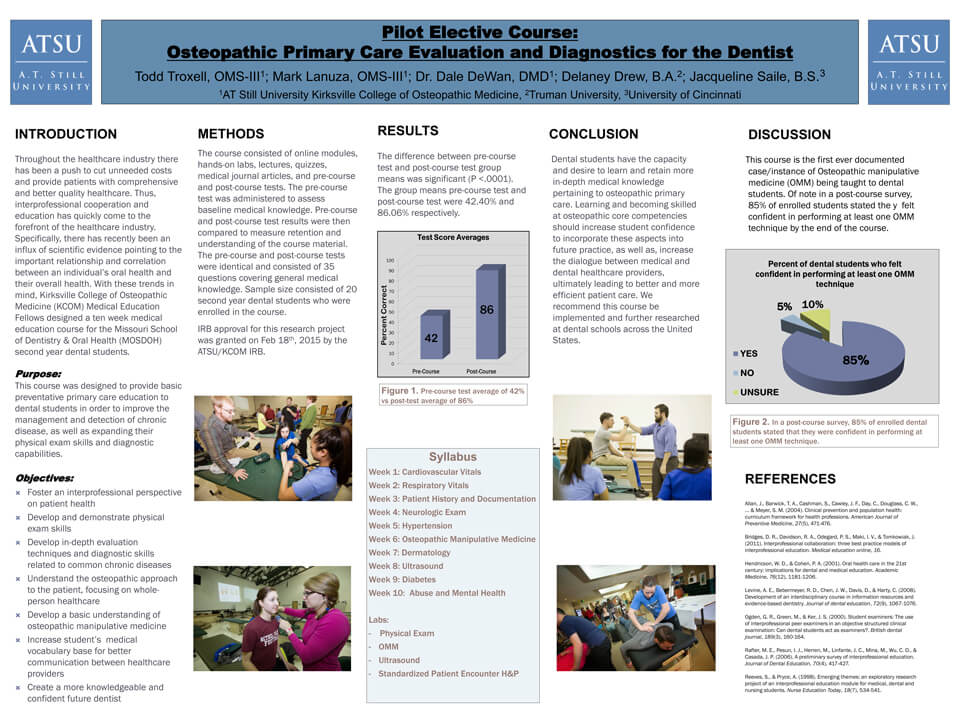Pilot Elective Course: Osteopathic Primary Care Evaluation and Diagnostics for the Dentist
Contributors:
Todd Troxell, OMS-III1
Mark Lanuza, OMS-III1
Dr. Dale DeWan, DMD1
Delaney Drew, B.A.2
Jacqueline Saile, B.S.3
Todd Troxell, OMS-III1
Mark Lanuza, OMS-III1
Dr. Dale DeWan, DMD1
Delaney Drew, B.A.2
Jacqueline Saile, B.S.3
Participating Organizations:
AT Still University Kirksville College of Osteopathic Medicine
Truman University
University of Cincinnati
AT Still University Kirksville College of Osteopathic Medicine
Truman University
University of Cincinnati
Introduction
Throughout the healthcare industry there has been a push to cut unneeded costs and provide patients with comprehensive and better quality healthcare. Thus, interprofessional cooperation and education has quickly come to the forefront of the healthcare industry. Specifically, there has recently been an influx of scientific evidence pointing to the important relationship and correlation between an individual’s oral health and their overall health. With these trends in mind, Kirksville College of Osteopathic Medicine (KCOM) Medical Education Fellows designed a ten week medical education course for the Missouri School of Dentistry & Oral Health (MOSDOH) second year dental students.
Throughout the healthcare industry there has been a push to cut unneeded costs and provide patients with comprehensive and better quality healthcare. Thus, interprofessional cooperation and education has quickly come to the forefront of the healthcare industry. Specifically, there has recently been an influx of scientific evidence pointing to the important relationship and correlation between an individual’s oral health and their overall health. With these trends in mind, Kirksville College of Osteopathic Medicine (KCOM) Medical Education Fellows designed a ten week medical education course for the Missouri School of Dentistry & Oral Health (MOSDOH) second year dental students.
Methods
The course consisted of online modules, hands-on labs, lectures, quizzes, medical journal articles, and pre-course and post-course tests. The pre-course test was administered to assess baseline medical knowledge. Pre-course and post-course test results were then compared to measure retention and understanding of the course material. The pre-course and post-course tests were identical and consisted of 35 questions covering general medical knowledge. Sample size consisted of 20 second year dental students who were enrolled in the course. IRB approval for this research project was granted on Feb 18th, 2015 by the ATSU/KCOM IRB.
The course consisted of online modules, hands-on labs, lectures, quizzes, medical journal articles, and pre-course and post-course tests. The pre-course test was administered to assess baseline medical knowledge. Pre-course and post-course test results were then compared to measure retention and understanding of the course material. The pre-course and post-course tests were identical and consisted of 35 questions covering general medical knowledge. Sample size consisted of 20 second year dental students who were enrolled in the course. IRB approval for this research project was granted on Feb 18th, 2015 by the ATSU/KCOM IRB.
Results
The difference between pre-course test and post-course test group means was significant (P <.0001). The group means pre-course test and post-course test were 42.40% and 86.06% respectively.
The difference between pre-course test and post-course test group means was significant (P <.0001). The group means pre-course test and post-course test were 42.40% and 86.06% respectively.
Conclusion
Dental students have the capacity and desire to learn and retain more in-depth medical knowledge pertaining to osteopathic primary care. Learning and becoming skilled at osteopathic core competencies should increase student confidence to incorporate these aspects into future practice, as well as, increase the dialogue between medical and dental healthcare providers, ultimately leading to better and more efficient patient care. We recommend this course be implemented and further researched at dental schools across the United States.
Dental students have the capacity and desire to learn and retain more in-depth medical knowledge pertaining to osteopathic primary care. Learning and becoming skilled at osteopathic core competencies should increase student confidence to incorporate these aspects into future practice, as well as, increase the dialogue between medical and dental healthcare providers, ultimately leading to better and more efficient patient care. We recommend this course be implemented and further researched at dental schools across the United States.
Discussion
This course is the first ever documented case/instance of Osteopathic manipulative medicine (OMM) being taught to dental students. Of note in a post-course survey, 85% of enrolled students stated they felt confident in performing at least one OMM technique by the end of the course.
This course is the first ever documented case/instance of Osteopathic manipulative medicine (OMM) being taught to dental students. Of note in a post-course survey, 85% of enrolled students stated they felt confident in performing at least one OMM technique by the end of the course.
